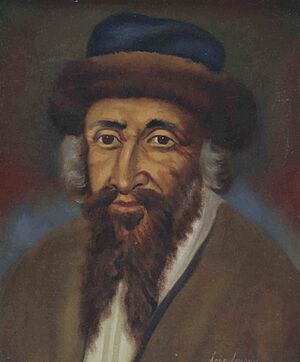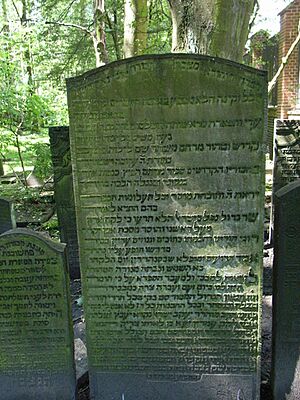Jacob Emden facts for kids
Quick facts for kids Jacob Emden |
|
|---|---|

Rabbi Jacob Emden
|
|
| Religion | Judaism |
| Personal | |
| Born | June 4, 1697 Altona, Holstein, Holy Roman Empire |
| Died | April 19, 1776 (aged 78) Altona, Holstein, Holy Roman Empire |
| Children | Meshullam Solomon |
| Parents |
|
| Signature |  |
Jacob Emden (born June 4, 1697 – died April 19, 1776) was a very important German rabbi and talmudist. He was also known as Ya'avetz. He strongly supported traditional Judaism. This was at a time when a new movement called Sabbateanism was becoming popular. People admired him for his vast knowledge.
Jacob Emden was the son of Tzvi Ashkenazi, a famous Jewish scholar. He was also related to Elijah Ba'al Shem of Chełm. Emden lived most of his life in Altona, which is now part of Hamburg, Germany. His son, Meshullam Solomon, became the rabbi of the Hambro Synagogue in London.
The name Ya'avetz (יעב"ץ) is a special Hebrew abbreviation. It stands for "Yaakov (Emden) ben Tzvi." This means "Jacob (Emden) son of Tzvi," referring to his father's name.
Seven of his 31 books were published after he passed away.
Contents
Rabbi Jacob Emden's Life Story
Jacob Emden, whose birth name was Ashkenazi, was the fifth of his father's fifteen children.
Early Education and Family Life
Until he was seventeen, Emden studied the Talmud with his father, Tzvi Ashkenazi. His father was a top expert in Jewish law. They studied first in Altona, then in Amsterdam from 1710 to 1714.
In 1715, Emden married Rachel. She was the daughter of Mordecai ben Naphtali Kohen, a rabbi in Ungarisch-Brod, which is now in the Czech Republic. Emden continued his studies at his father-in-law's yeshivah (a Jewish school).
He became very skilled in all areas of Talmudic study. Later, he also learned about philosophy, kabbalah (Jewish mysticism), and grammar. He tried to learn Latin and Dutch. However, he believed that Jewish people should only study non-religious subjects if they couldn't study the Torah (Jewish holy texts).
His Career as a Rabbi and Scholar
Emden spent three years in Ungarisch-Brod. There, he taught Talmud privately. After that, he worked as a dealer in jewelry and other items. This job made him travel a lot.
He usually didn't want to be a rabbi. But in 1728, he agreed to become the rabbi of Emden. He took his name from this city.
He later moved back to Altona. The Jewish community there allowed him to have his own private synagogue. At first, Emden was friends with Moses Hagiz, who led the Portuguese-Jewish community in Altona. However, their friendship ended because of false rumors. His relationship with Ezekiel Katzenellenbogen, the chief rabbi of the German community, also started well but quickly got worse.
A few years later, the King of Denmark gave Emden permission to open a printing press in Altona. He soon faced criticism for publishing his siddur (prayer book) called Ammudei Shamayim. This was because he openly criticized powerful local money changers. His opponents kept speaking against him, even after his work was approved by the chief rabbi of the German communities.
The Ya'avetz Pen Name
In the introduction to his book She'I'Las Yaavetz, Emden shared a story from his childhood. He asked his father, the Chacham Tzvi, why he signed his name simply as Tzvi. His father explained that Tzvi stood for "Tzvi ben Yaakov" (Tzvi son of Jacob).
His father then told him that when he grew up and wrote books, he should sign them as Ya'avetz. The first two Hebrew letters of Ya'avetz (Yud and Ayyin) would stand for Yaakov. The last two letters would represent "ben Tzvi" (son of Tzvi).
The name Yaavetz also appears in the Bible. It is mentioned in 1 Chronicles 2:55 as a place. It is also found in 1 Chronicles 4:9-10 as a person's name.
Other Important Events

In 1756, leaders of the Synod of Constantinov asked Emden for help. They wanted to stop the Sabbatean movement. Since the Sabbateans often referred to the Zohar (a Jewish mystical text), Emden decided to study it closely. After his research, he believed that a large part of the Zohar was not truly ancient but written by someone pretending to be an old author.
Emden's writings show he had a very strong critical mind. This was rare among scholars of his time. He was very traditional and never strayed from Jewish customs. This was true even when times and situations had changed.
Sometimes, Emden's ideas seemed very unusual compared to strict traditional Judaism. However, they were not so strange in the more open-minded circles of the Enlightenment. Emden was friends with Moses Mendelssohn, who started the Haskalah (Jewish Enlightenment) movement. He also knew several Christian scholars.
In 1772, Frederick II, Duke of Mecklenburg-Schwerin, made a rule. It said that people could not be buried on the same day they died. Jewish people in his lands asked Emden for help. They wanted him to show from the Talmud that waiting longer to bury a body was against Jewish law.
Emden sent them to Mendelssohn. Mendelssohn had a lot of influence with Christian leaders and wrote excellent German. Mendelssohn wrote the letter to the Duke as requested. But he privately told Emden that, based on the Talmud, the Duke seemed to be right. Emden wrote back strongly. He said it was silly to claim that the custom of the entire Jewish people was completely wrong. He also told Mendelssohn that such a claim would only make rumors of his lack of religiousness stronger.
Jacob Emden's Beliefs
Emden was a traditional thinker. He responded to the ideas of tolerance that were popular during the 18th-century Enlightenment. He expanded traditional Jewish ideas of inclusion in a very broad way.
Like Maimonides, he believed that religions that worship one God (like Christianity and Islam) have important roles. He thought they were part of God's plan for humanity. He wrote that "we should consider Christians and Muslims as instruments for the fulfilment of the prophecy that the knowledge of God will one day spread throughout the earth."
Emden praised the moral teachings of Christianity. He thought they helped remove idol worship and gave non-Jews good moral guidance. He also suggested that strict Christian practices could help improve the soul, similar to how Jewish commandments do.
Emden wrote that he owned books with non-religious wisdom written in Hebrew. He said he would read them in the bathroom. He did not like philosophy. He believed that the ideas in The Guide for the Perplexed could not have been written by Maimonides. Instead, he thought they were written by an unknown person who held different beliefs.
Published Works
Jacob Emden wrote many books. Here are some of his important published works:
- Edut BeYaakov: This book discusses the supposed false beliefs of Eybeschütz. It also includes a letter to the rabbis of the "Four Lands." Published in Altona, 1756.
- Shimmush: This work contains three smaller books. They are Shoṭ la-Sus, Meteg laHamor, and Sheveṭ leGev Kesilim. These books discuss the growing influence of the Sabbatean movement and argue against their ideas. Published in Amsterdam, 1758–62.
- Shevirat Luchot haAven: This book argues against Eybeschütz's "Luchot Edut." Published in Altona, 1759.
- Mitpachat Sefarim: This book has two parts. The first part suggests that some of the Zohar is not truly ancient. The second part criticizes other books and includes letters to the rabbi of Königsberg. Published in Altona, 1761–68.
- Lechem Shamayim: This is a commentary on the Mishnah. It also includes a two-part study on Maimonides' Mishneh Torah, Beit haBechirah. Published in Altona, 1728; Wandsbeck, 1733.
- She'elat Ya'abetz: This is a collection of 372 answers to religious questions. Published in Altona, 1739–59.
- Siddur Tefillah: This is an edition of the Jewish prayer book. It includes comments, grammar notes, religious laws, and other writings. It has three parts: Beit-El, Sha'ar haShamayim, and Migdal Oz. Published in Altona, 1745–48.
- Etz Avot: A commentary on Pirkei Avot (Ethics of the Fathers), with grammar notes called Lechem Nekudim. Published in Amsterdam, 1751.
- Seder Olam Rabbah and Zutta: These are two historical works, along with Megillat Ta'anit. Emden edited them with critical notes. Published in Hamburg, 1757.
- Mor uKetziah: New insights on Orach Hayyim (a section of Jewish law).
- Megillat Sefer: This book contains biographies of himself and his father. Published in Warsaw, 1897.
The Emden Siddur
There are printings from the 20th century (Lemberg 1904, Augsburg 1948) with the cover title "Siddur Beis Yaakov" (also called Siddur Bet Yaakov). Their covers say "Jacob from Emden" in Hebrew.
The 472-page Lemberg 1904 printing includes a section for Tikun Leil Shavuot (a special study session on the night of Shavuot). This prayer book is much larger than Emden's other siddur, Shaarei ShaMaYim.
Shaarei ShaMaYim
A smaller prayer book, reprinted in Israel in 1994, was titled Siddur Rebbe Yaakov of Emden on the top half of the cover. Below that, it said Siddur HaYaavetz Shaarei ShaMaYim. This prayer book has less detailed comments than the full Emden siddur. For example, it does not include Tikkun Leil Shavuot. It is a two-volume set, shown as the first two books on the left side in the photo.
Images for kids




